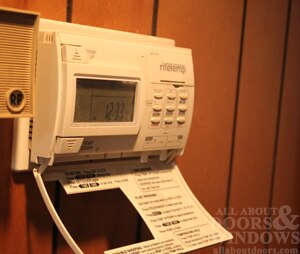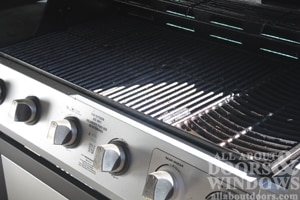5 Tips to Keep Your Home Cool and Your Costs Cooler This Summer
 1. Install a Programmable Thermostat (or Program the One You Have):
1. Install a Programmable Thermostat (or Program the One You Have):
Install a programmable thermostat so you can control the way the air conditioner behaves when you're not home. If you already have one, make sure you know how to get the most out of it. Even during the hottest months of the year, the air doesn't need to be blasting if you're not home or asleep. Set it to turn down when you're not home and kick in half an hour before you get home and after you go to bed to save money and energy. Additionally, never manually turn the temperature on your thermostat more than than a couple degrees down at a time--each degree makes a big difference. If it's still too hot after an hour, then turn it down a couple more degrees.
 2. Close Your Curtains During the Day:
2. Close Your Curtains During the Day:
Curtains make more of a difference than you might think, and you probably already have them installed. Close the curtains during bright, hot days to shelter your house and furniture from the sun's heat. Your house can quickly absorb excess heat if the curtains are left open, forcing automatic air conditioners to work harder. And when your AC bill gets bigger, your wallet gets smaller.
3. Replace Your Weatherstrip and Door Sweeps:Similarly to curtains, you already have door sweeps and weatherstrip installed around your windows and doors. Many people rush to replace these right as cold weather starts to kick in in the fall, but they can be just as useful at keeping cool air inside during the summer as they are at keeping cold air outside during winter. Replace any torn, ripped or loose weatherstrip--the point is to create a rubber or foam seal between outside and inside. Door sweeps can also become ripped or start to fall off--replace these as needed to keep cold air from escaping under exterior doors. Weatherstrip and door sweeps are relatively inexpensive and can be found on our website.
4. Install a Whole-House Fan:Whole-house fans suck air in from outside through open windows. Turn it on in the evenings, and you'll get cool air coming in the house; the fan takes the absorbed hot air in the home and sends it out through the attic. These are best suited in areas with mild to warm climates all year round--and could be installed as an alternative to air conditioning. In climates with more extreme heat, even at night, whole-house fans may be an option for the spring and fall months before temperatures climb. Whole-house fans use less energy than air conditioners and pay for themselves much quicker. Initial purchase and installation should typically fall between $700-$1500.
*Note: Whole-house fans require adequate ventilation, open windows and proper installation to ensure that there is no backdraft from gas appliances. Please research all whole-house fan safety concerns before purchasing and installing yourself.
 5. Grill Outside Instead of Heating Up the Oven:
5. Grill Outside Instead of Heating Up the Oven:
Your oven and stove are heat machines. Firing up the oven or stove on a hot day not only pours heat into your house, but also kicks automatic air conditioners into high gear, wasting your precious dollars. Try firing up the outdoor grill instead--we even have a Pinterest board of recipes we think sound delicious.
